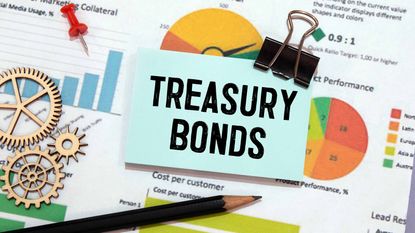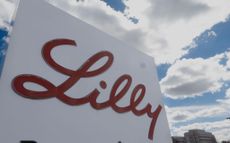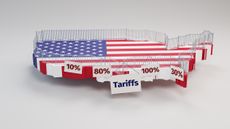Best SPDR ETFs to Buy and Hold
With markets enjoying a historic soft landing, these six SPDR ETFs give investors options to build a solid, low-cost portfolio for the long term.


State Street's job as an investment manager is to get you from point A to point B with as little pain as possible and, hopefully, with plenty of assets in your retirement portfolio.
And, to its credit, many of its best SPDR ETFs do precisely that.
State Street now boasts more than 150 ETFs under the SPDR nameplate. The most famous — not to mention the largest SPDR — is the S&P 500 ETF Trust (SPY, $588.63) with net assets of $627.7 billion.
SPY launched the ETF era roughly 30 years ago, and investors are better for it.
Are SPDR ETFs a good investment?
For investors wondering where to invest, State Street's SPDR ETFs offer a broad range of options that allow them to build a core portfolio while taking occasional shots to capture some of the benefits of higher-growth sectors.
This is especially important amid the upheaval of recent years and what appears to be a historic soft landing in 2024.
"There have been just four soft landings in history — in 1968, 1985, 1995, and now, in 2024," writes State Street Chief Investment Strategist Michael Arone in the firm's 2025 ETF Market Outlook. "Because soft landings are so rare, market participants don’t have a lot of data points to make bold predictions about the future. But, historically, economic growth has accelerated in the years following a soft landing. And that pattern is likely to repeat in 2025."
For investors focused on the long term versus the day-to-day of the market, here are six of the best SPDR ETFs to buy and hold for at least the next few years.
Of course, depending on your personal needs, you might load up on certain funds while ignoring others. But this list of the best ETFs offers options for just about every core portfolio objective.
Data is as of January 7. Dividend yields represent the trailing 12-month yield, which is a standard measure for equity funds.

Financial Select Sector SPDR ETF
- Assets under management: $48.0 billion
- Dividend yield: 1.4%
- Expenses: 0.09%, or $10 annually for every $10,000 invested
The Financial Select Sector SPDR ETF (XLF, $48.33) is one of the most widely watched sector funds on this list of SPDR ETFs. XLF tracks the performance of the Financial Select Sector Index, a collection of financial stocks within the S&P 500 Index.
XLF struggled amid as rising interest rates caused problems for regional bank stocks early in 2023. But shares stabilized and began to rebound in October of that year, setting the stage for XLF to rise 28.4% in 2024.
And the ETF has been stellar for shareholders over the long haul: The Financial Select Sector SPDR ETF has generated a total return (price change plus dividends) of 135.6% over the last 10 years.
This SPDR fund has 72 holdings with a weighted average market cap of $332.2 billion. The ETF's top 10 positions account for 54% of its $48.0 billion in total assets. Warren Buffett's holding company Berkshire Hathaway (BRK.B) is the only stock with a weighting above 10% at 13.4%.
The top three industries by weight in XLF are financial services (31.8%), banks (24.1%) and capital markets (23.1%), followed by insurance (16.7%) and consumer finance (4.2%).
Regarding growth and valuation, XLF's estimated earnings per share over the next three to five years is 14.1%. The average holding has a price-to-book (P/B) ratio of 2.3 and a price-to-earnings (P/E) ratio of 18.0.
Investing in XLF offers investors a chance to participate in the growth of one of the best SPDR ETFs at a reasonable price.

SPDR S&P 1500 Value Tilt ETF
- Assets under management: $391.8 million
- Dividend yield: 2.0%
- Expenses: 0.12%
Value stocks started to make a comeback late in 2021 after years in the wilderness. Rising interest rates had something to do with that.
However, the underperformance of value stocks for over a decade has made rising interest rates almost irrelevant as many former value investors moved to index funds.
"Value investing as an industry is dead... The money has moved from value investors to index funds, and it's not coming back," Greenlight Capital founder David Einhorn told CNBC in early 2023.
But not everyone feels the same way, including Warren Buffett, who has long been an advocate of value-based investing. This is because value stocks tend to be "companies that are built with solid balance sheets and provide a steady flow of cash back to shareholders via dividends rather than investing aggressively in expanding their operations," writes Kiplinger contributor Jeff Reeves.
And despite having just $391.8 million in total assets, the SPDR S&P 1500 Value Tilt ETF (VLU, $184.93) makes an excellent option for investors wanting broader exposure to value stocks. Plus, Morningstar gives it a five-star rating.
VLU tracks the performance of the S&P 1500 Low Valuation Tilt Index, which takes the S&P Composite 1500 Index and applies a value tilt. So, companies with low P/E, P/B, price-to-sales (P/S) and price-to-cash flow (P/CF) ratios and those that pay dividends are given a composite value based on the last five years of data.
The fund then divides the 1,500 names into 20 sub-portfolios based on relatively equal market caps. The individual stocks in those sub-portfolios are then weighted based on their composite valuation. The index is rebalanced annually on the third Friday in April.
The value ETF holds 1,438 names in its portfolio. The fund's weighted average market cap is $448.9 billion, making it a decidedly large-cap investment. The top 10 holdings account for 19.1% of the portfolio.
Blue chip stocks Apple (AAPL), Berkshire Hathaway and Amazon.com (AMZN) are the three largest holdings currently in SPDR S&P 1500 Value Tilt ETF, with weights of 2.63%, 2.4% and 2.29%, respectively.
If you're interested in a diversified portfolio of stocks with a value tilt, VLU is tops among the best SPDR ETFs.

SPDR Portfolio Developed World ex-US ETF
- Assets under management: $21.3 billion
- Dividend yield: 3.2%
- Expenses: 0.03%
Most core ETF portfolios should consider a global fund that excludes U.S. stocks. That's to avoid home-country bias, the conscious or unconscious act of sticking to one's own country when selecting investments.
"Just like sports teams recruit the best players, the goal of investing should be to win by using diverse talent. You may not find what you need at home, and to be competitive you need to look across borders," Chicago-based financial services firm Northern Trust stated in a 2022 report on home-country bias.
According to the authors of that report, "Diversification is the one 'free lunch' in investing. Adding foreign equity investments to a domestic portfolio helps produce more diversified portfolios and alleviates concentration risks related to investing domestically only."
The SPDR Portfolio Developed World ex-US ETF (SPDW, $34.53) is one of the best SPDR ETFs for this diversification.
The ETF tracks the performance of the S&P Developed Ex-U.S. BMI Index (Broad Market Index). This float-adjusted, cap-weighted index represents a collection of publicly traded companies based in developed countries other than the U.S. The index is a subset of the S&P Global BMI.
Stocks included in the index must have a float-adjusted market cap of at least $100 million and sufficient six- and 12-month daily volume. Once included in the index, a stock's float-adjusted market cap can drop as low as $75 million.
There are currently companies from 25 countries represented in the fund. The top three countries by weight are Japan (22.6%), the United Kingdom (12.1%) and Canada (10.9%).
SPDW has approximately 2,500 holdings with a weighted average market cap of $72.0 billion. The three top sectors by weight are financials (21.9%), industrials (17.9%) and consumer discretionary (11%). Not only is it diversified among countries and sectors, but it's also diversified among companies. The top 10 holdings account for less than 10% of the ETF's $21.3 billion net assets.
It charges just 0.03%, a very inexpensive way to avoid home-country bias.

SPDR S&P Kensho New Economies Composite ETF
- Assets under management: $2.1 billion
- Dividend yield: 1.0%
- Expenses: 0.20%
The SPDR S&P Kensho New Economies Composite ETF (KOMP, $52.02) is one of six thematic ETFs from S&P Kensho. It seeks to expose investors to innovation trends such as alternative finance, smart borders, cybersecurity and many more.
Kensho got its start in 2013. It uses artificial intelligence (AI), machine learning (ML), speech recognition and other innovative technology to drive fact-based decision-making. S&P Global acquired the company for $550 million in 2018.
The fund tracks the performance of the S&P Kensho New Economies Composite Index, a collection of U.S.-listed companies based in developed and emerging markets that are driving innovation. The index is rebalanced semi-annually on the third Friday in June and December.
"KOMP utilizes natural language processing to scan regulatory filings and identify innovative companies related to more than 20 innovation areas. KOMP's approach not only identifies leading companies in each innovation area, but also seeks to capture the entire ecosystems supporting them," the fund's fact sheet states.
The SPDR S&P Kensho New Economies Composite ETF currently has about 440 companies in its portfolio. The top 10 holdings account for roughly 10% of its $2.1 billion in total net assets.
Its biggest weightings at 1.2% each are Teledyne Technologies (TDY), which makes enabling technologies such as digital imaging sensors, at 1.2%, and Intuitive Machines (LUNR), a company focused on the development of space communications and navigation technology.
The top three sub-industries by weight are aerospace and defense (11.8%), application software (11.6%) and health care equipment (6.5%). Turnover is relatively high due to the growth nature of the ETF, which turns about two-thirds of its holdings every year.
Performance-wise, KOMP posted a gain of a little more than 10% in 2024. Over the long term, the SPDR ETF has averaged an annual return of 10.5% since its October 2018 inception.

SPDR Dow Jones Global Real Estate ETF
- Assets under management: $1.1 billion
- Dividend yield: 3.7%
- Expenses: 0.50%
Following the home-country bias theme, the SPDR Dow Jones Global Real Estate ETF (RWO, $42.34) invests about a third of its $1.1 billion in net assets outside the U.S.
Commercial real estate lending accelerated off the COVID-19 bottom in 2022, generating renewed excitement in the industry. However, as interest rates increased, commercial loans slowed early in 2023. Multiple regional bank failures only amplified these concerns.
But RWO stabilized and started to rally in October 2023 as inflation pressures began to ease and interest rates started to slide, generating a total return of more than 30% through the middle of September 2024.
RWO has retreated as rates have risen since the Fed started cutting interest rates, but investors looking to hold for the long haul should do well with RWO. The ETF was launched in May 2008 in the middle of the financial crisis. So it's seen a cycle or two.
The SPDR ETF tracks the performance of the Dow Jones Global Select Real Estate Securities Index (RESI), a collection of real estate investment trusts (REITs) and real estate operating companies.
To qualify for inclusion in the index, a company must be an equity owner and operator of commercial or residential real estate. Mortgage REITs are excluded, as are specialty REITs investing in timber, railroads, cell towers and other related infrastructure. Service providers such as real estate agents and mortgage brokers are also excluded.
Another condition of inclusion is all new constituents must have a minimum float-adjusted market cap of $200 million. And it's out if it falls below $100 million for two consecutive quarters.
In addition, new constituents must generate 75% of their annual revenue from owning and operating real estate assets. Existing companies are booted if the percentage drops below 50% or direct mortgage investments rise above 25%. The SPDR Dow Jones Global Real Estate ETF wants actual real estate owners and operators.
RWO currently has 227 holdings, including Amazon.com warehouse owner Prologis (PLD) and data center REIT Equinix (EQIX).
The top three real estate sectors by weight are retail (19.6%), residential (14.1%) and industrial (13.8%). The biggest country exposure is the U.S. (73.3%), followed by Japan (7.8%) and the U.K. (3.4%). The top 10 holdings account for 39% of the ETF's net assets.

SPDR Portfolio Short Term Treasury ETF
- Assets under management: $5.3 billion
- SEC yield: 4.5%*
- Expenses: 0.03%
It's always good to include one bond ETF in a core portfolio. Even amid uncertainty about inflation and interest rates, the comfort of a U.S. government-backed fund hits the right note.
That's why the SPDR Portfolio Short Term Treasury ETF (SPTS, $28.97) is on this list of the best SPDR ETFs.
SPTS tracks the performance of the Bloomberg 1-3 Year U.S. Treasury Index. The index, which is updated on the last business day of every month, measures short-term investment-grade U.S. Treasuries with a remaining maturity of more than one year and fewer than three, with $300 million or more outstanding. All constituents are denominated in U.S. dollars, with a fixed rate, and are non-convertible. Inflation-protected Treasuries, known as TIPS, are excluded.
SPTS has 104 holdings, with an average maturity of 1.94 years, an average yield to maturity of 4.3% and an average coupon of 2.9%. Approximately 56% of the SPDR Portfolio Short Term Treasury ETF's holdings mature in one to two years, with another 44.1% maturing within two to three years. The short duration makes them less sensitive to interest rate fluctuations.
* SEC yields reflect the interest earned after deducting fund expenses for the most recent 30-day period and are a standard measure for bond and preferred-stock funds.
Learn more about SPTS at the SPDR provider site.
Related content
Get Kiplinger Today newsletter — free
Profit and prosper with the best of Kiplinger's advice on investing, taxes, retirement, personal finance and much more. Delivered daily. Enter your email in the box and click Sign Me Up.

Will has written professionally for investment and finance publications in both the U.S. and Canada since 2004. A native of Toronto, Canada, his sole objective is to help people become better and more informed investors. Fascinated by how companies make money, he's a keen student of business history. Married and now living in Halifax, Nova Scotia, he's also got an interest in equity and debt crowdfunding.
-
 Eli Lilly Stock Rises After Profit, Outlook Top Expectations
Eli Lilly Stock Rises After Profit, Outlook Top ExpectationsEli Lilly stock is higher Thursday after the pharma giant beat fourth-quarter profit expectations and issued strong 2025 guidance. Here's what you need to know.
By Joey Solitro Published
-
 Trump Wants You Out of the IRS, But You'll Have to Wait Until May
Trump Wants You Out of the IRS, But You'll Have to Wait Until MayIRS Some IRS employees won’t be able to resign using the buyout offer until the end of tax season.
By Gabriella Cruz-Martínez Published
-
 Stock Market Today: Stocks Waver as Big Tech Slumps on Spending Concerns
Stock Market Today: Stocks Waver as Big Tech Slumps on Spending ConcernsMarkets seesawed amid worries over massive costs for artificial intelligence and mixed economic news.
By Dan Burrows Published
-
 Stock Market Today: Earnings Speak Louder Than Tariffs
Stock Market Today: Earnings Speak Louder Than TariffsRecent market reaction to Trump administration policy announcements has been "entirely normal."
By David Dittman Published
-
 The DeepSeek Crash: What It Means for AI Investors
The DeepSeek Crash: What It Means for AI InvestorsDeepSeek's R1 model represents both risk and opportunity. Here's what DeepSeek means for AI investors.
By Tom Taulli Published
-
 Stock Market Today: Stocks Trim Losses After Trump Tariffs
Stock Market Today: Stocks Trim Losses After Trump TariffsStocks slumped at the start of Monday's session after the Trump administration's weekend tariff announcement.
By Karee Venema Published
-
 How Do Tariffs Impact the Stock Market?
How Do Tariffs Impact the Stock Market?There are plenty of moving parts when it comes to tariffs. Here, we look at what impact tariffs have on the stock market and your portfolio.
By Charles Lewis Sizemore, CFA Published
-
 Stock Market Today: Trump Tariff Worries Pressure Stocks
Stock Market Today: Trump Tariff Worries Pressure StocksStocks swung lower Friday after the White House confirmed it will impose tariffs on Mexico, Canada and China beginning tomorrow.
By Karee Venema Published
-
 Stock Market Today: Investors Adjust to Earnings and Guidance
Stock Market Today: Investors Adjust to Earnings and GuidanceThe stock market struggles in a good way when it's measuring what's happening on the ground.
By David Dittman Published
-
 Stock Market Today: Stocks Jump Around on Fed Day
Stock Market Today: Stocks Jump Around on Fed DayFed Chair Jerome Powell plays it as straight as possible while President Trump and threats to the AI rally abound.
By David Dittman Published
